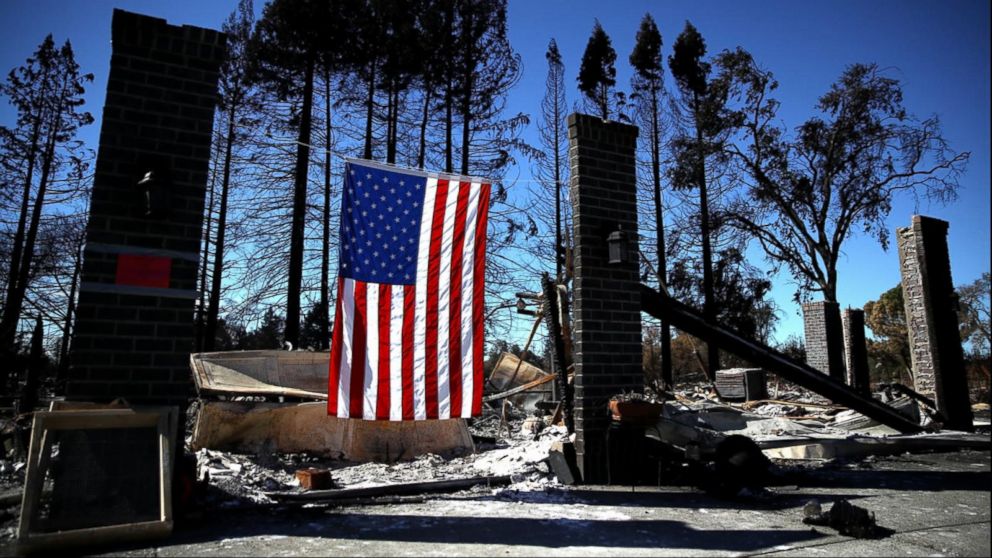
Transcript for Residents return to Santa Rosa to rebuild after Tubbs fire tragedy: Part 2
The author Toni Morrison once wrote about a loneliness that roams. Alive on its own, the kind you can’t tuck away. Perhaps that was the feeling on this morning. October 9th, 2017. It’s like a frickin’ train coming through here. Reporter: When residents slowly returned to find what they once knew, now alien. It was hard to take in, it was hard to really grasp for a while. Reporter: This is what Jeff acrepki came home to, ruins where his house once stood. Not everyone suffered the same outcome. The fire dangled people between two fates. Look. Look at this. Wow. Reporter: Those who were spared — Oh my gosh, we didn’t get touched. Reporter: And those who lost everything. They weren’t so lucky. No, they weren’t. When you first laid sight on your house, or what was left of it, what went through your mind? I wanted to be sick. It’s just all gone. Everything we’ve worked for. It’s all gone. In the days after, you hear a lot of people say, at least everybody’s safe, they’re just things, it’s just stuff. In your mind you’re just like, you want to cuss them out because it’s not just stuff. It’s the memorial flag for my wife’s father. She lost her dad in Iraq and that’s all we have of him. My son’s blankie. My son’s favorite toy. Those aren’t just things, those are remnants of our lives and other people’s lives that we don’t have anymore. Reporter: The fire killed 22 and laid waste to 3,000-plus residences, some the homes of first responders who worked tirelessly to evacuate others, like firefighter Paul Lowenthal. When it hit me, it was day five. Our fire chief, Tony gosner, and Jonathan cox, the chief of Cal fire, pulled me aside and said, you’re done, you need a time-out, you need a break. I looked at him and said, what do you want me to do? I don’t really have anything to go to. When you went home, what was that like? Not as hard as trying to explain to my daughter that our home was destroyed in the fire. She wanted to get back what she had before. I get it. But at the same time, it’s an opportunity for us to start over, start a new chapter. Reporter: Charlie and date Higgins marked the start of their new chapter by hanging this symbol, one that for them meant perseverance. I’m coming back. Coming back. Reporter: In the days that followed, the cleanup began. A couple things. Reporter: The most commonplace items now personal treasures. This is our house number from our house. Oh my gosh. It looks literally like a surreal piece of artwork. Oh, yeah. Oh yeah. That is just how we found it. Reporter: As time passed, so many in Santa Rosa were still displaced, still mourning, and longing to be home for the holidays. That was the only place I felt that I belonged. Reporter: Her friend Ronnie wanted her to know she still did. One night we drove over there. There’s Ronnie. And he put a big 15-foot Christmas tree on my lawn. Reporter: As more trees were trimmed, the sound of caroling echoed through the streets. ??? Rudolph the red-nosed reindeer ??? Reporter: A simple truth discovered — that home is in the heart. With the new year, new hope. This is the living room. Yeah. Our fireplace will go there. Reporter: Nancy proudly shows us the makings of her new home. This is one of the bedrooms. This is the master bath. Reporter: She’s hoping to move back in by the end of this year. As is Kate Higgins. Every time we come, there’s a little more done. It means we’re a little closer to being back home. Feels like a little piece of you is being put back together. Reporter: Roughly 27% of the homes lost are now under construction, or have completely rebuilt. People don’t understand why we’re letting people rebuild back in those areas that have burned. The reality is a lot of those homes were older homes, built before the standards went into effect. The idea is now that that construction will protect those homes. Through the construction, with the fuel reduction, it will make those homes successful in surviving a wildfire. Reporter: So many in Santa Rosa live in constant fear that disaster could strike again. Climate science has found that longer, drier periods have created tinder box conditions that when sparked and mixed with coastal winds are leading to high-speed infernos. Like the one we saw earlier this week that destroyed the city of paradise, California. We’re seeing them time and time again. It’s definitely becoming the new norm. Reporter: Now perhaps the community of paradise, just hours away, will look to Santa Rosa for lessons in their own recovery. The only good thing that’s come out of this disaster is the neighborhood coming together. We’re stronger together now than we were a year ago. Reporter: On this night, the first anniversary of the fire — I want to invite you to stand here together in community. Reporter: Close to 500 people park. You can burn our neighborhood to the ground but you can’t take our community spirit. What you’re finding is the strength, the hope, the love, the life. It’s back. Reporter: A community that stands firm in its resolve, that loneliness will roam no longer.
This transcript has been automatically generated and may not be 100% accurate.





